“On Retirement Income” series:
- A 4% Rule Fable
- The 4% Rule Launches a Bigger Discussion
- From Mindless Inconsistency to Mindless Consistency
- Stock/Bond Portfolios and Sequence-of-Returns Risk
- Goals-Based Investing Starts with Goals
- Guaranteed Income Sources (Social Security, Etc.)
- How Guaranteed is Guaranteed Income?
- Get Real Income by Getting TIPSy
- More to come…
Background
It has been nine months since our last article in this series, during which time our intrepid author[1] has unfurled a 16,000-word banner proclaiming the correct way to think about long-horizon investing, uncovered a tax gotcha at our custodian, blown the trumpet of awesomeness for a new mutual fund lineup, and performed his day job.[2]
Thankfully, the two clients we’ve kept on the hook this whole time are both fictional, so they have raised no complaint over their extended wait, nor have their financial circumstance evolved since they were placed in stasis. Which means we can pick right up where we left off, as though nothing happened!
Let’s see, where did we leave off?…
Fred needs five years of Social Security replacement income, and Bob and Barbi need more secure income than Social Security will give them
Ah yes. In the sixth article in this series, we told Bob and Barbi that we could fill in the gap between what Social Security will pay and what their budget says their “required/inflexible” income needs will be. We also provisionally convinced Fred to wait until age 70 to file for Social Security. The provision was that we could demonstrate how this allows him to start spending more money—safely—right away. The full demonstration requires more than what this article alone can offer him, but the first step is to create an “income bridge” to starting Social Security in five years—a bridge that offers the same inflation-protected (a.k.a., “real”) income certainty.
The primary construction material for Fred’s bridge (and Bob’s…er…skyway?) is Treasury Inflation-Protected Securities, or TIPS. If you wish to learn about TIPS in excruciating detail, our past articles are more than happy to oblige.[3] The main point is this: Because TIPS payouts adjust for inflation, they can be used to generate inflation-protected future income, even though we don’t know what future inflation will be. I.e., the higher the inflation, the higher the future payout[4] from a TIPS position, and vice versa.
Thus, with TIPS, an investor can emulate the cash flows from Social Security, enabling supplemental real income above Social Security and/or real income in the near term to facilitate delaying Social Security claiming until age 70. This is why TIPS are the primary ingredient in Layer 2 of Round Table’s Layer Cake system.[5]
Let’s examine the latter use case first, since it’s simpler.
Social Security “bridge” income: Fred’s solution
In Part 6, we showed Fred that if he waited five years to start claiming Social Security, he could get $45,500/year in real income vs. just $32,000/year if he starts now. But Fred wants to retire now, so he needs to create cash flow to take the place of Social Security over the next five years. To do this, he can set aside $45,500 in cash to cover the first year,[6] and then purchase four TIPS bonds, one for each subsequent year until he starts Social Security.
Referencing TIPS interest rates as of the time of this writing, we estimate that we can generate, by this means, $45,500 of real income for five years for an up-front cost of about $225,000. In real dollars, the two options look like this:
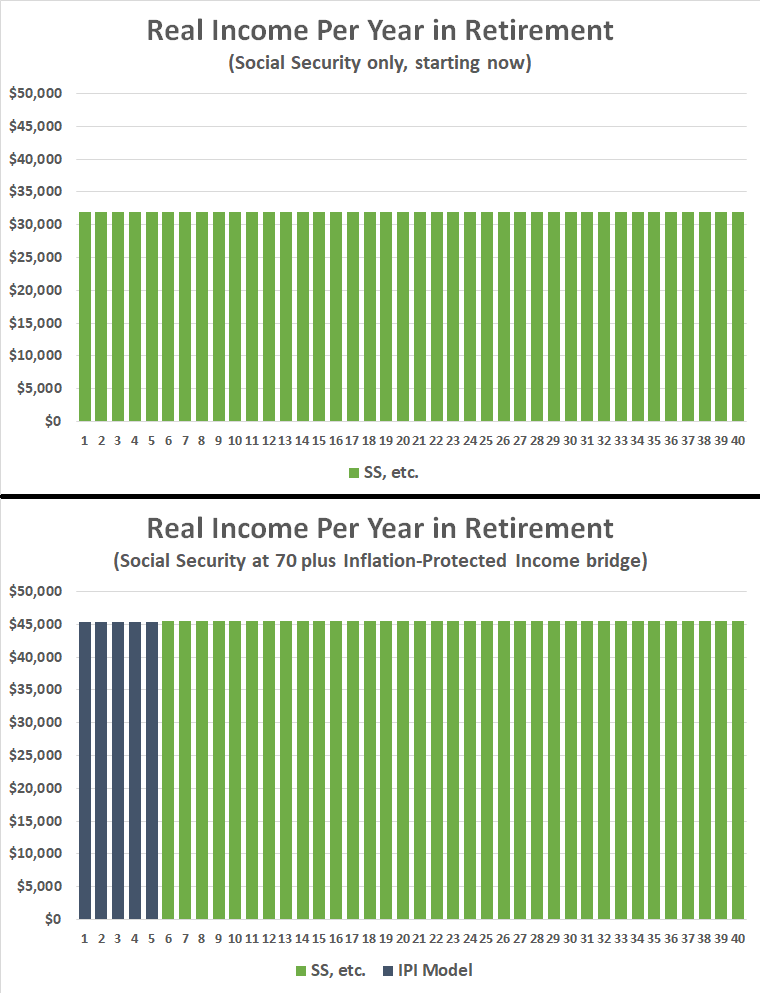
By waiting to claim Social Security at age 70 and backfilling with an inflation-protected income bridge of TIPS, Fred goes from having $32,000/year in safe, secure, inflation-protected income (with Social Security alone) starting this year to having $45,500/year in safe, secure, inflation-protected income also starting this year.
The charts above show real (meaning inflation-adjusted) income. In nominal (non-inflation-adjusted) terms, the amount of income produced will vary depending on the inflation rate. Here are a few examples of what Fred’s nominal income from TIPS and Social Security could look like:
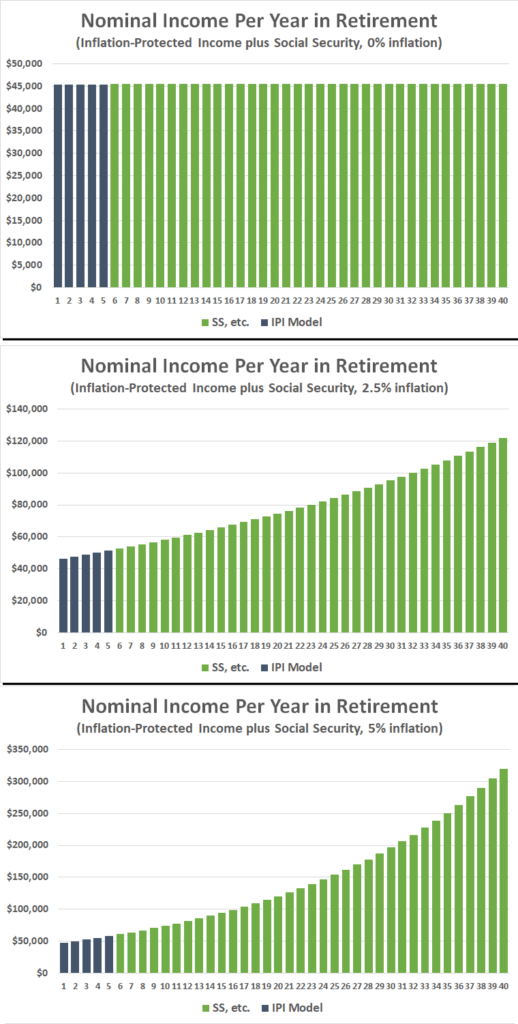
The “money illusion” is a phenomenon whereby people tend to view nominal income and real income as if they were the same thing. As the examples above show, this is only true in the unlikely event that inflation holds steady at 0%. With a more probable 2.5% inflation rate, inflation-protected income is the difference between $45,500 and over $84,000 in 25 years. And remember, inflation is the aggregate increase in the cost of goods and services, which means $84,000 would be required to buy the same amount of stuff that you can buy with $45,500 today. To put that in perspective, below is what $45,500/year in nominal income looks like at those same three inflation rates.
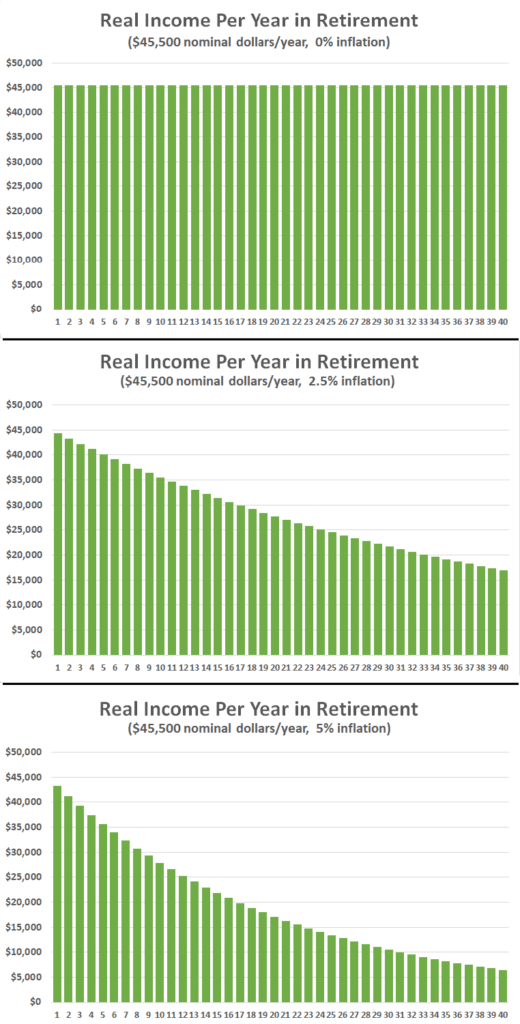
With just a 2.5% inflation rate, $45,500 will be able to buy only about $24,500 worth of stuff in 25 years. This is why we strongly encourage our clients to overcome the money illusion, both to think in real-dollar terms and to stockpile real-dollar income, especially when it comes to covering “inflexible” needs—which, by definition, is “stuff” the same amount of which you continue to purchase each year.
Fred is convinced about the benefits of inflation-protected income. But he is a sharp guy, and he realizes that “start today” vs. “delay to 70 with a TIPS bridge” is not an apples-to-apples comparison. “Sure, I get $13,500 more in lifetime real income, but I’d have to spend $225,000 to get it! How is that an improvement?” Our ability to answer this question properly is part of the magic of the full-fledged Layer Cake Monte Carlo system, but because our tour of the Layer Cake model is only half-complete, the full answer to Fred’s question is something for which he, and you, will have to stay tuned! As a sneak peak, though, compare this effective 6% ($13,500/$225,000) inflation-protected, lifetime safe withdrawal rate to the “4% Rule” ROT Investment Advisors suggested to Fred in the first article in this series!
Supplemental real income: Bob and Barbi’s solution
Part 6 established that, between Barbi’s Social Security (starting at age 70), Bob’s Social Security (starting at age 67 and then switching to a spousal benefit at 70), and an extremely convenient four-year fixed annuity, Bob and Barbi’s guaranteed income sources look something like the following, in real-dollar terms.
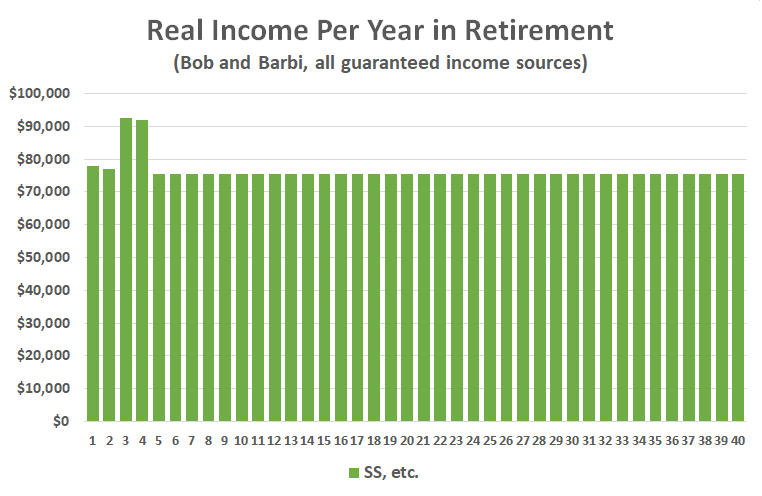
Among other (nice!) complexities, years 3 and 4 illustrate the extra income we found for Bob by encouraging him to file at his full retirement age while Barbi holds off until age 70. But to simplify the discussion from this point forward, we are going to use the approximation that they receive ~$75,000 in real income each year starting now, which looks like the following.
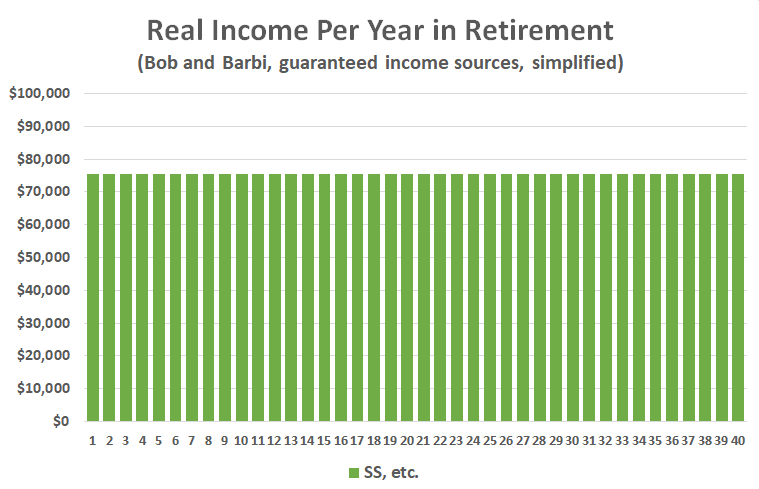
In a real-life financial plan, we would embrace all the gory real-life detail. Often, we will fashion a complementary income strategy to smooth out these complexities, like fill dirt leveling the furrows and ridges in a lumpy field of cash flows. (Or…something…) But in a fictional financial plan, simpler is…well, simpler.
The retirement budget Bob and Barbi developed in Part 5 rolled up to the following inflexible, flexible, and total annual expenses.

$75k/year covers the lion’s share of inflexible expenses, but a gap of $6,250 remains. Once again, it’s TIPS to the rescue! In a previous article, we described in depth how Round Table uses TIPS to generate a long-term stream of inflation-protected income. For example, at present rates (and net of our management fees), we tell Bob and Barbi that we can generate $6250 in annual real income for 25 years for an up-front investment of about $165,000.
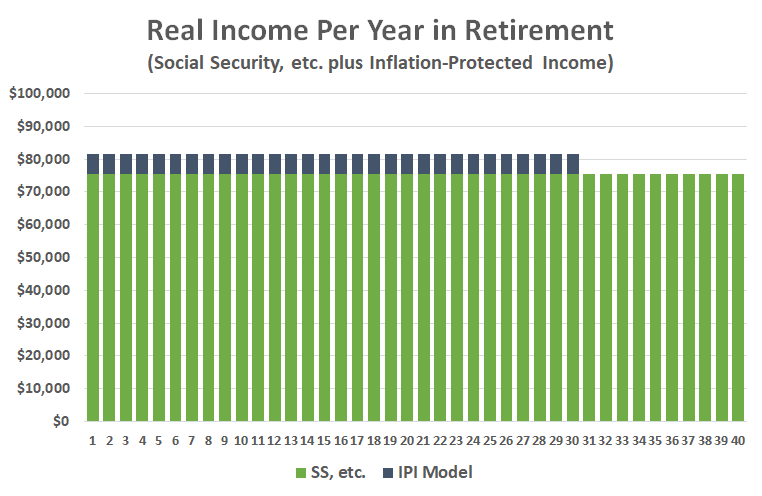
This will take Bob to age 95 and Barbi to age 96. Remarkably, by using a combination of TIPS and a new mutual fund called a “LifeX Inflation-Protected Income Fund,” we could also generate the same real income to age 100 for Barbi for about $160,500 or for Bob for about $157,000. We described these new funds in detail in this article. In brief, these funds also invest in TIPS for inflation-protection, and they utilize mortality pooling, the key technique of annuity products, to produce income all the way to age 100, in exchange for the fund investors forgoing, after age 80, the ability to sell the funds or receive any value after death. The remaining fund value when an investor passes away is redistributed to all living investors in the fund, and by this means the full pool of investors effectively provides longevity insurance for each individual investor. This is, for example, why this approach costs less for Bob than for Barbi (despite Barbi being one year older), since male life expectancy is lower.
Here’s what that option looks like. Five extra years of income are available (note that the 40 years in the chart would take Bob to age 105), provided Bob remains alive to age 100. As noted in the chart, we consider Round Table’s technique for investing in LifeX funds to be another variation on our “Inflation-Protected Income” (IPI) model, Layer 2 of the Layer Cake.
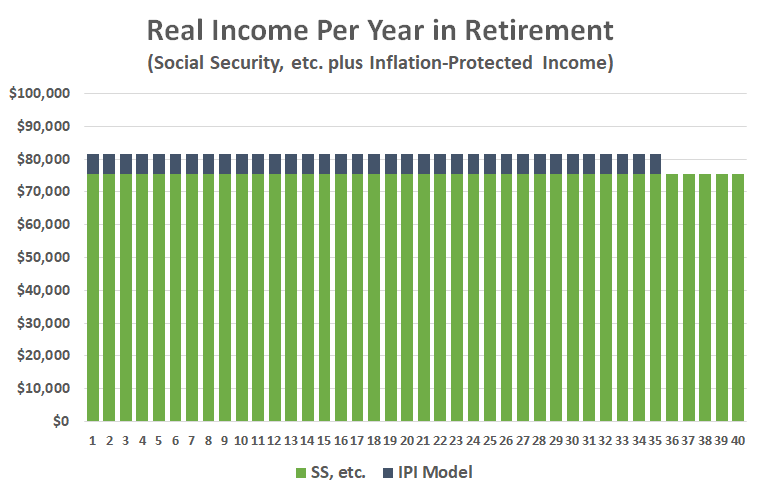
The loss of liquidity and legacy value after age 80 is a downside of the LifeX approach, though we would argue that the fact that it can create more years of longevity- and inflation-protected income for fewer dollars than a TIPS ladder can also be viewed as freeing up additional dollars to invest toward legacy, both because fewer dollars are required to make the purchase, and because fewer dollars would need to be earmarked for potential longevity protection.
In our view, a more significant downside is that LifeX funds are currently only available on individual life. If, for example, we bought the income for Bob, and if Barbi significantly outlived Bob, then Barbi would lose the LifeX stream of income. We’re hoping for an eventual “joint-life” solution—i.e., a product that pays out until both spouses pass away—but for now we can walk our clients through the various pros and cons.
Another option for longevity protection is a “deferred income annuity” (DIA). A DIA is a contract that can be purchased now to create income for life starting in the future, and it can offer a joint-life option. We can typically only obtain quotes for DIAs with income starting no later in life than age 90. And unfortunately, at present there are no DIA products offering true inflation protection.[7] We explain to Bob and Barbi that we can only make a best guess at inflation in the interim. If we assume, for example, a 2.5% inflation level, then it would take about $11,600 of nominal income to generate $6,250 of buying power in 25 years. If we purchase a DIA for that level of income and the inflation guess turns out correct, then real income to age 90 followed by a DIA might look like the following. (Notice that the real income trails off after year 31, because inflation continues to gnaw away at the DIA’s buying power.)
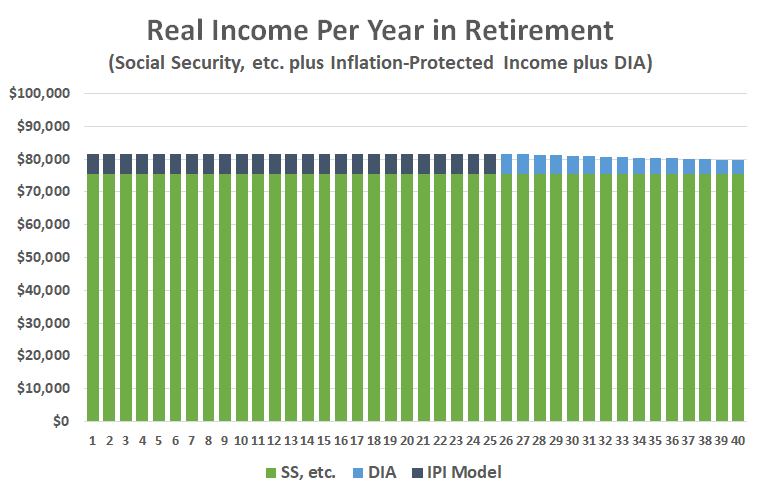
But if inflation comes in unexpectedly high (say, 5%), then the buying power of the DIA will be impaired.
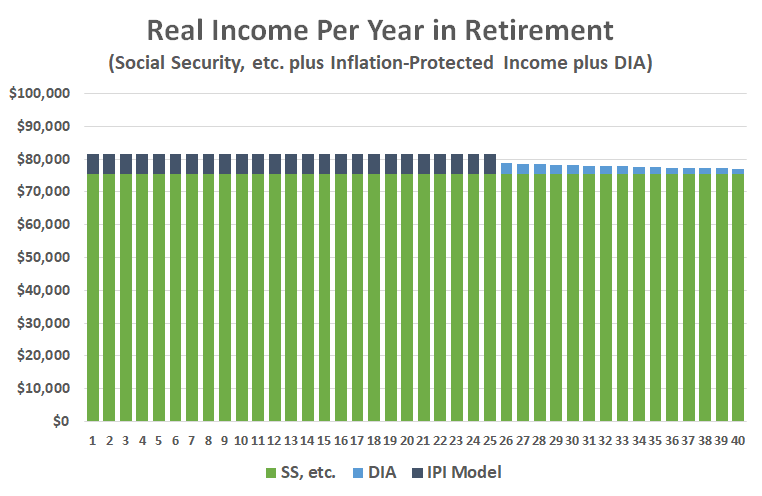
Notably, this option (inflation-protected income to 90, then non-inflation-protected income for life) would also cost approximately $160,000—about $143,000 for the TIPS ladder and about $17,000 for the DIA.[8]
For the same up-front cost ($160,000), we present Bob and Barbi with the following three options to generate the remaining income required to cover the inflexible expenses not already covered by Social Security:
- Buy a TIPS ladder to create $6,250 of real income over the next 28 years (i.e., to age 93 for Bob). This option offers no longevity protection, but all remaining asset value converts to legacy if Bob and Barbi pass away earlier.
- Utilize Round Table’s LifeX plus TIPS strategy, split between Bob and Barbi, generating $3,125 real income each, up to age 100. This option maximizes inflation- and longevity-protected income, but minimal legacy will remain if Bob and Barbi pass away after age 80.
- Buy a TIPS ladder to cover the next 25 years (to age 90 for Bob), plus a nominal DIA to provide non-inflation-protected income for as long as Bob or Barbi are still alive. This option provides fewer years of inflation-protected income vs. option 1, and correspondingly lower legacy in the event of early demise, in exchange for joint-life longevity protection, albeit without inflation protection.
This is not a simple decision! If a joint-life LifeX fund existed, it would cost more than the LifeX option for Barbi (let alone for Bob), but we suspect we would consider it a dominant strategy to all three options above.
After a discussion about all three options, our editor decided that Bob and Barbi choose option 2 for now, with the understanding that they have until December 31 of the year each spouse turns 80 to change their minds. (Again, see my article about the LifeX funds for details.) Who knows, maybe an option for joint-life, inflation- and longevity-protected income will emerge in the meantime!
Wait, we’re only half done? This is eight articles already!
Detailed goals-based retirement planning is hard! But that’s because real life is complicated (even for simplified, fictional “real lives” like those of our twin brother clients). If you’ve read this far, we suspect you’re the sort of person who wants to know the details of how we address that complexity. But if not, rest assured that we’re happy to shield our clients from as much complexity as possible, if that’s what they prefer, while still matching up their assets to their goals.
But yes, it’s true. Eight articles in and we’ve only made it halfway up the layers of our Layer Cake retirement investing solution. After all, we haven’t yet deciphered how to cover the remainder of Bob and Fred’s annual income needs, let alone how to meet other goals like large, one-time purchases, emergencies, and possible long-term care.[9] Much more is yet to come!
[1] Okay, I’ve never been called “intrepid.” But come on, who would you rather have ushering your retirement through the maze of financial complexity, someone intrepid or someone cautious?
[2] I know, excuses, excuses…
[3] Yes, that’s nine articles focused on or heavily involving TIPS. But don’t worry, that’s a curated list, and we have more if you need them!
[4] I’m using the loose term “payout” here rather than “income,” because the largest element of a TIPS payout comes from the return of the (inflation-adjusted) face value at maturity, rather than the “income” from coupon payments. As we keep mentioning, the coupon income is really more of an annoyance than a benefit.
[5] So TIPS can be an ingredient in a cake and a construction material for a bridge? Sheesh, even I didn’t know they were that flexible!
[6] Technically this can be done with less, since some of the cash can be placed in interest-bearing accounts until the month(s) it is needed.
[7] By this we mean a cost-of-living adjustment (COLA) linked to an inflation index, such as CPI-U. Fixed-percentage COLAs are no substitute, as I’ve argued before and as retirement researcher David Blanchett demonstrated magnificently in his recent article on the subject.
[8] To generate this estimate, I used this annuity calculator: https://www.schwab.com/annuities/fixed-income-annuity-calculator This calculator won’t quite offer a DIA quote to age 90, so I estimated a downward adjustment to the quoted cost of a joint DIA with income beginning at age 87. As the DIA is inexpensive to begin with, the estimation error should not detract too severely from the accuracy of the $160,000 overall cost estimate.
[9] Or addressed taxes at all. Yeah, that matters…
